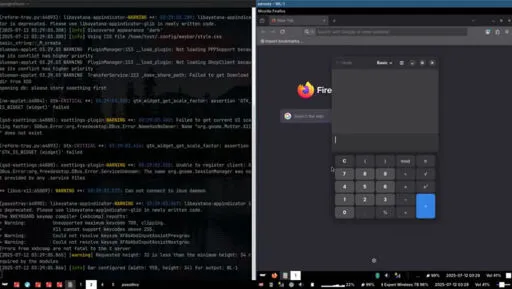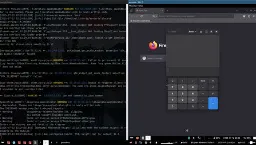How to Xephyr in Sway: running nested Sway sessions as other users
How to Xephyr in Sway: running nested Sway sessions as other users

Nested Sway sessions

Author @ExtremeDullard@lemmy.sdf.org How to Xephyr in Sway: running nested Sway sessions as other users
If you come from i3, you might be missing Xephyr or Xnest-like functionalities in Sway - that is, the ability to run another desktop session as another user inside your current desktop.
In i3, I log into my test desktops all the time without leaving my main desktop, and that's something I really miss in Sway / Wayland. So I spent some time putting a script together to do that seamlessly in Sway too. You may find it useful.
In fairness, Sway - or more precisely wlroots - can already run nested natively without any modification. You can test that by opening a terminal and typing sway in it: you'll get a second, identical desktop inside your current one.
The problems come when you want to run another user's desktop within yours, for the following reasons:
- Wayland makes the incredibly restrictive assumption that the Wayland compositor and clients always run as the same user, and therefore puts the Wayland socket in the user's XDG_RUNTIME_DIR (usually
/run/user/<userid>/).That's a problem if you want a Wayland application running as another user to connect to that Wayland socket, because other users can't access your XDG_RUNTIME_DIR, and you really don't want to open it up to other users just to be able to access the socket because it's full of sensitive files pertaining to your running session.Moreover, since XDG_RUNTIME_DIR is usually a mounted tmpfs, you can't symlink the socket outside the directory either because sockets can't be symlinked across filesystems in Linux.In other words, again, Wayland makes it extra difficult to do something simple for no good reason. - Sway requires a full login environment - and particularly XDG_RUNTIME_DIR - to be set in the environment, which usually implies that it should also be setup and mounted in
/run/user.Unfortunately, you can't just sudo into the account you want to run your nested Sway desktop as and start Sway because PAM explicitely doesn't set XDG when su'ing or sudo'ing, and doing it manually is a recipe for problems.
To solve 1., we use a clever piece of software called filterway, which conveniently solves two problems:
- It acts as a sort of gateway: it connects to a Wayland socket on one side, creates its own socket on the other side and links the two. This functionality is used to expose the primary Wayland socket securely without compromising XDG_RUNTIME_DIR.
- It replaces the app ID of the top Wayland client that connects to it - which is really its primary party trick. In this use case, that's useful to track the state of the nested Sway session in the primary session's tree.
There is no package for filterway so you have to clone the Github repo, build the binary and install it somewhere in your PATH. Fortunately, it's just a small utility so building it is really simple.
To solve 2., we use systemd-run to setup the target user's environment as if it was a full login, then run Sway with the correct setup to connect to the primary Wayland display's socket.
The following script ties everything together: it starts filterway, starts Sway as the other user, then takes care of stopping Sway and filterway and cleaning things up when the session is closed. Alll you need is to add your name to the sudoers.
bash
#!/bin/sh
# Make sure we run in Wayland
if [ ! "${WAYLAND_DISPLAY}" ]; then
echo "$0 must be run in a Wayland environment"
exit
fi
# Make sure we run in Sway
if [ ! "${SWAYSOCK}" ]; then
echo "$0 must be run in a Sway session"
exit
fi
# Pass the nested session's user as first argument
if [ ! "$1" ]; then
echo "Usage: $0 username"
exit
fi
NUSER=$1
# Make sure the nested session's user exists
# Replace "password" with "passwd" here, change due to Lemmy posting glitch
if ! grep -q "^${NUSER}:" /etc/password; then
echo "User ${NUSER} doesn't exist"
exit
fi
# Make sure filterway is installed
if ! which -s filterway; then
echo "filterway not found in the PATH."
echo "Please install if from https://github.com/andrewbaxter/filterway"
exit
fi
# Get a unique ID for this nested session
UUID=$(uuidgen)
# Figure out where our Wayland socket is and make sure it exists
if echo ${WAYLAND_DISPLAY} | grep -q "^/"; then
RSOCKPATH=${WAYLAND_DISPLAY}
else
RSOCKPATH=${XDG_RUNTIME_DIR}/${WAYLAND_DISPLAY}
fi
if ! [ -S ${RSOCKPATH} ]; then
echo "Socket file ${RSOCKPATH} for this Wayland display \"${WAYLAND_DISPLAY}\" doesn't exist!?"
echo "Giving up..."
exit
fi
# Unique nested session's Wayland display name
NWDISPLAY=wayland-nested-${UUID}
# Unique filespec for the nested session's Wayland socket
NSOCKPATH=/tmp/${NWDISPLAY}
# Unique filespec for the nested Sway socket
NSWAYSOCK=/tmp/sway-nested-ipc.${NUSER}.${UUID}.sock
# Run filterway in the background to expose our private Wayland socket in ${XDG_RUNTIME_DIR} (which is most likely a tmpfs-mounted directory that can't be shared outside without compromising the private $(XDG_RUNTIME_DIR}) and to rename the nested session's app ID
rm -f ${NSOCKPATH}
filterway --upstream ${RSOCKPATH} --downstream ${NSOCKPATH} --app-id "Nested Sway - ${NUSER} ($UUID)" &
FILTERWAY_PID=$!
# Wait until filterway has created the socket and associated lock files for the nested session
RETRY=3
while [ ${RETRY} -gt 0 ] && ! ( [ -S ${NSOCKPATH} ] && [ -f ${NSOCKPATH}.lock ] ); do
sleep 1
RETRY=$((RETRY-1))
done
# If filterway somehow didn't start, try to kill it and clean up its files for good measure
if [ ${RETRY} = 0 ]; then
kill ${FILTERWAY_PID}
rm -f ${NSOCKPATH} ${NSOCKPATH}.lock
fi
# Fix up the permissions of the socket and associated lock files for the nested session so it's only accessible to the owner
chmod 600 ${NSOCKPATH} ${NSOCKPATH}.lock
# Become root
sudo -s -- << EOF
# Give the socket and associated lock files to the nested session's user
chown ${NUSER}: ${NSOCKPATH} ${NSOCKPATH}.lock
# Remove stale symlinks then start Sway as that user in a new session in the background
systemd-run --pipe --machine ${NUSER}@ --setenv=WAYLAND_DISPLAY=${NWDISPLAY} --setenv=SWAYSOCK=${NSWAYSOCK} --user /bin/sh -c '[ "\${XDG_RUNTIME_DIR}" ] && (find \${XDG_RUNTIME_DIR} -maxdepth 1 -name "wayland-nested-*" -xtype l -exec rm -f {} \; || true) && rm -f \${XDG_RUNTIME_DIR}/${NWDISPLAY} && ln -s ${NSOCKPATH} \${XDG_RUNTIME_DIR}/${NWDISPLAY} && sway' &
# Wait for the Sway container to appear within 3 seconds after starting Sway, then wait for it to disappear for more than 5 seconds afterwards
export SWAYSOCK=${SWAYSOCK}
COUNTDOWN=3
while [ \${COUNTDOWN} -gt 0 ]; do
if swaymsg -t get_tree | grep -q 'app_id.*${UUID}'; then
COUNTDOWN=5
fi
sleep 1
COUNTDOWN=\$((COUNTDOWN-1))
done
# Stop the nested Sway
SWAYSOCK=${NSWAYSOCK} swaymsg exit
# Kill filterway
kill ${FILTERWAY_PID}
# Remove the filterway socket and socket lock files
rm -f ${NUSER}: ${NSOCKPATH} ${NSOCKPATH}.lock
EOF
I called it nest_sway.sh and it lives in my ~/scripts directory, which is in my PATH. Whenever I want to start a desktop as another user within my desktop, I simply type
console
$ nest_sway.sh <username>
and hey-presto, the desktop appears. Just like with Xephy.
